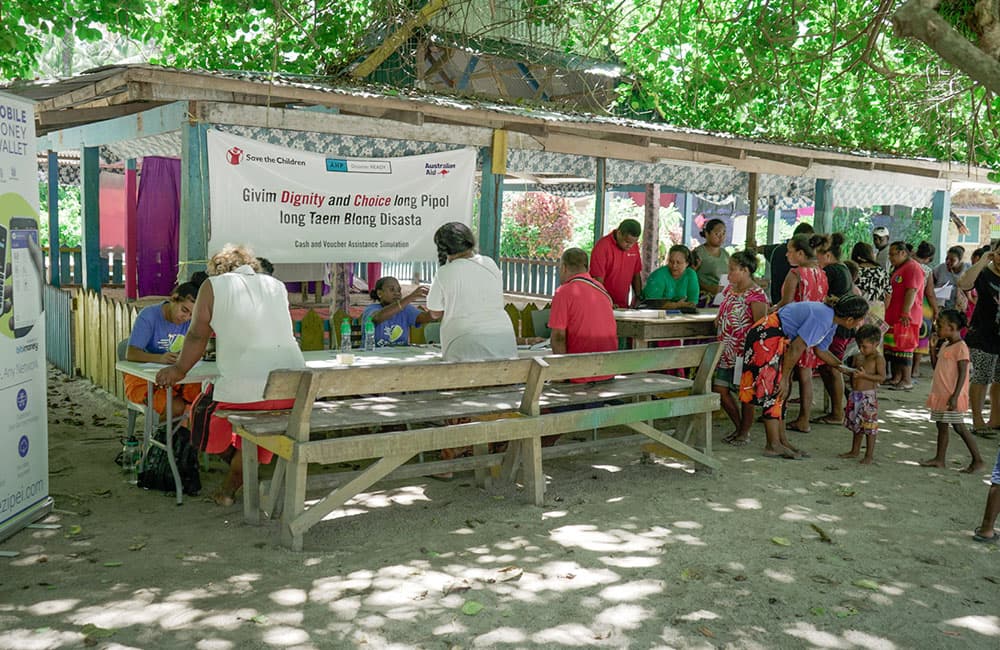Save the Children in an Emergency
When disaster strikes, Save the Children is on the ground providing lifesaving support to children and their families. As leaders in the humanitarian field, our teams are always ready to go. In times of crisis, we provide food, clean water, healthcare and shelter, as well as services such as education and protection support for children.
We have been responding to emergencies for over 100 years and work closely with local leaders to understand what’s needed after a disaster - be it a cyclone, tsunami or a pandemic. But we know that families know best what they need to get back on their feet after an emergency.
While we continue to provide direct support to children who need it most, cash transfers give families impacted by disaster the flexibility they need to help themselves in a dignified way and ensure children and families get exactly what they need during times of crisis.

Save the Children working with their local partners to trial cash and voucher assistance
in Titiana Village in the Solomon Islands.
Photo: Collin Leafasia/Save the Children Solomon Islands.
Why Cash?
With climate change exacerbating the frequency and severity of disasters, Save the Children is taking critical steps to prepare for whenever a crisis hits. Our experience tells us that cash is often the best way to help children and families access what they need after a disaster. Cash and Voucher Assistance is safe, fast and effective – and because recipients spend their money locally, they help the economy bounce back too.
For example, if a cyclone devastated a village in the Solomon Islands, one family might find that their children’s clothes and school supplies have been washed away. After receiving a cash transfer from Save the Children, the family could quickly buy what they need from a local market. Their neighbours may have instead seen all their crops damaged and can use a cash transfer to purchase seeds and tools to replant their garden with. By spending their money at nearby shops, both families will help shop owners stay in business and keep the local economy afloat.
But most importantly, cash gives people in crisis the dignity to choose what they need most. Providing cash transfers empowers families to meet their own needs and build back better from disaster.
Who receives cash?
Before implementing cash transfers, Save the Children conducts a vulnerability assessment to ensure payments go to the hardest to reach and most vulnerable families. We conduct surveys with people impacted by disaster to understand their situation. Our teams make calls or travel door to door to ask families what their needs are, how many people are seeking help, what income sources they have and if the family is accessing any other services.
After the vulnerability assessment is complete, Save the Children alerts recipients that their payment is coming. Cash can be given via notes, vouchers or it can be distributed via mobile phones. By helping families to register for mobile payment systems, we can help them quickly access cash in the immediate crisis they’re facing - and in future ones like it.
In instances where vouchers are more appropriate, Save the Children will give families a time and central place where they can collect their payment.
How do we know it works?
In recent years, Save the Children has been using Cash and Voucher Assistance across the globe to respond to emergencies. We have seen time and time again that cash assistance can save lives. Our research shows us that cash payments significantly contribute to reduced child mortality, improved access to education, and to reducing harm and exploitation of children. This is particularly true if cash is combined with long term, complementary programs.
Save the Children is an implementing partner of Disaster READY, an Australian Government initiative to strengthen disaster preparedness and management across the Pacific and in Timor Leste. With the support of the Australian Humanitarian partnership, our programs in the Pacific are building and trialling cash transfer and e-voucher systems. From participating in disaster simulations, we’ve learnt what works and what doesn’t, helping us to strengthen our mechanisms to provide lifesaving support for children in crisis.
Take a look at a Cash and Voucher Assistance simulation in action: